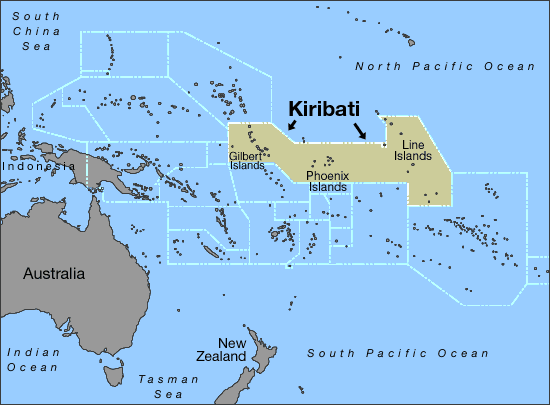 hile
rich nations tinker with policies that may shave their carbon dioxide
emissions, low-lying South Pacific nations such as Kiribati are
sinking beneath the waves.
hile
rich nations tinker with policies that may shave their carbon dioxide
emissions, low-lying South Pacific nations such as Kiribati are
sinking beneath the waves.
W hile
rich nations tinker with policies that may shave their carbon dioxide
emissions, low-lying South Pacific nations such as Kiribati are
sinking beneath the waves.
hile
rich nations tinker with policies that may shave their carbon dioxide
emissions, low-lying South Pacific nations such as Kiribati are
sinking beneath the waves.
The tiny nations of the Pacific, where some of the world's lowest-lying islands are situated, would be the first to be swamped. Those considered particularly vulnerable, as well as Kiribati, are Vanuatu; the Marshall Islands; Tuvalu and parts of Papua New Guinea.
I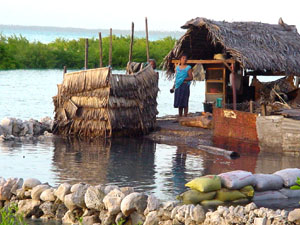 n
Micronesia the sea level has risen 21.4mm every year since 2001.
n
Micronesia the sea level has risen 21.4mm every year since 2001.
Kiribati, an archipelago of 33 coral atolls barely 6ft above sea level, is vanishing as global warming sees the oceans rise
The archipelago, strung across two million square miles of the Pacific, is home to 92,500 people. Most of them live on the densely populated main atoll, called Tarawa, a U-shaped chain of islets that are surrounding a central lagoon.
The beaches on Tarawa, an island nation which is pancake-flat and barely 500 yards wide, are so eroded that sand has been imported from Australia. Dozens of families have been forced to move, dismantling their wooden huts piece by piece and reassembling them further back from the water. Now the population is being squeezed into an ever narrower strip of land between the lagoon and the Pacific. www.kiribati.nl/images/dansertjes.jpg
Some 17,000 islanders migrating from some South Pacific island states already suffering rising sea levels applied for New Zealand residence in the last two years, compared with 4,000 in 2003. http://www.countercurrents.org/cc-perry111006.htm
low-lying coastal areas in the South Pacific are being devoured by soil erosion, higher sea levels and increasingly menacing storms
"Despite the fact that Pacific Island countries are low emitters of climate changing gases, they are in fact among the most vulnerable to the adverse impacts of climate change," says Diane McFadzien, WWF South Pacific's Regional Climate Change Coordinator
A12_s3_1
C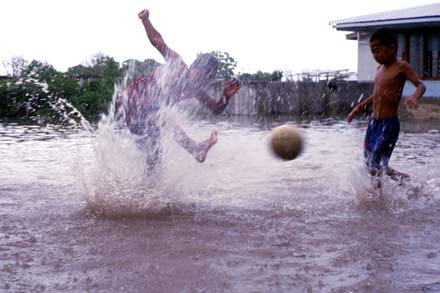 hildren
of the remote island of Tuvalu playing soccer in a flooded 'borrow'
pit during spring tides.
hildren
of the remote island of Tuvalu playing soccer in a flooded 'borrow'
pit during spring tides.
Tuvalu is a tiny constitutional monarchy made up of nine low-lying atolls, with a total land area of 26 square kilometers and an estimated population of 9,500.
The 3.2m high tides sparked the world's concern as they threatened to inundate the country. http://www.lonelyplanet.com/journeys/tuvalu/overview.htm
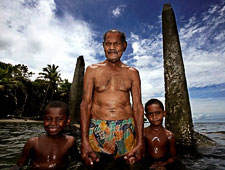 Villager
in Navua, Fiji, at his ancestral burial ground, which is covered by
the sea at high tide. © Brent Stirton/Getty
Images/WWF-UK
Villager
in Navua, Fiji, at his ancestral burial ground, which is covered by
the sea at high tide. © Brent Stirton/Getty
Images/WWF-UK
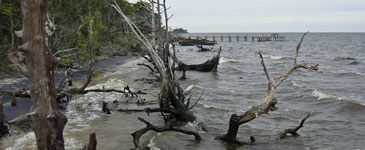
The population of Tuvalu, a group of eight Pacific islands north-east of Australia, is already being evacuated; nearly 3,000 Tuvalans have left so far. http://www.countercurrents.org/cc-mccarthy211006.htm
Low-lying islands in Australia's Torres Strait could be swamped by predicted sea level rises. (Pic: M. Horstman)
http://climateprogress.org/wp-content/uploads/2006/10/flood-disaster.jpg
For
the Pacific region, the number of people who experience flooding by
the 2050s could in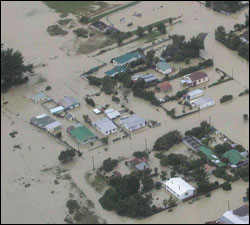 crease
by a factor of more than 50, to between 60,000 and 90,000 in an
average year .
crease
by a factor of more than 50, to between 60,000 and 90,000 in an
average year .
"As
well as the impact of flooding on settlements, the impact of
sea-level rise on freshwater quality and quantity is likely to be a
critical threat to Pacific Island health and welfare."
http://www.abc.net.au/science/news/health/HealthRepublish_849861.htm
A12_s3_2